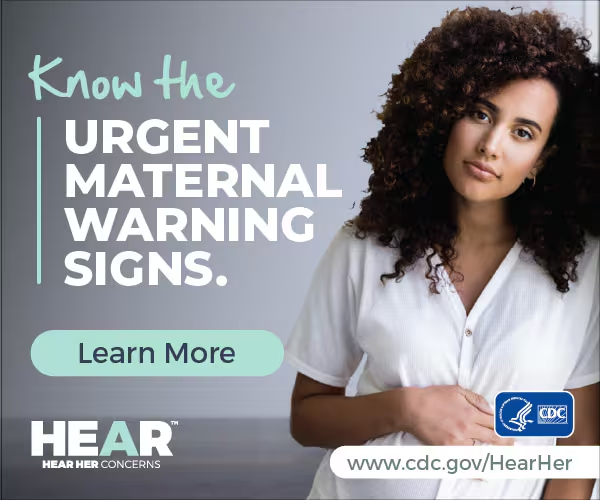
Over the past few years, I’ve been working with the CDC’s Division of Reproductive Health and Community Health Centers in different parts of the country to understand postpartum care needs, gaps in services, ongoing health disparities, and ways to strengthen care – especially for underserved women.
One of the first steps to improve care is to highlight the strengths of health centers and improve linkages with area hospitals. The relationships and communication between health centers, hospitals, Maternal Mortality Review Committees (MMRCs), and state-level Perinatal Quality Collaboratives (PQCs) are essential to decrease the high maternal mortality rates we see in the United States and the health disparities that lead to unnecessary deaths.
CDC is working to prevent pregnancy-related deaths
The CDC’s Division of Reproductive Health is pioneering in its work with us at NACHC and providers around the country to prevent pregnancy-related deaths. Dr. Lisa Hollier, the senior Medical Advisor in CDC’s Division of Reproductive Health explains:
“The latest national data from our Pregnancy Mortality Surveillance System, or PMSS, shows pregnancy-related mortality is not improving in the U.S. There are considerable racial-ethnic disparities – especially for Non-Hispanic Native Hawaiian and other Pacific Islanders, Black, American Indian, and Alaska Native people. Rural areas are also finding more pregnancy-related deaths than in urban areas. Data shows us that 22% of the deaths occurred during pregnancy, 25% during delivery or in the week after, and strikingly, 53% occurred in the postpartum period when people are not seeing their health care providers as frequently.”
Data from Maternal Mortality Review Committees (CDC funds MMRCs in 44 states and two territories) reveal that mental health conditions, hemorrhage or excessive bleeding, cardiac and coronary conditions, infection, thrombotic embolism, and cardiomyopathy accounted for over 75% of pregnancy-related deaths. Mental health conditions include deaths due to suicide, unintentional or unknown intent overdose or poisoning related to substance use disorder are also threats. Leading causes vary by race and ethnicity.
What can we do about these terrible statistics?
Maternal Mortality Review Committees identified many factors that contribute to maternal mortality and can be addressed at the patient, family, provider, facility, and community levels. We’ve learned many healthcare providers may not be aware of the 15 warning signs. Diagnoses are often missed or delayed, or treatments are missed or delayed. Continuity of care, especially for women in high-risk groups, is often not happening.
MMRCs determined that one or more reasonable change to patient, family, provider, facility, system, or community factors could prevent 84% of pregnancy-related deaths!
Why is the Hear Her Campaign valuable?
The Hear Her campaign was developed to shine a spotlight on the urgent maternal warning signs during or in the year after pregnancy. Also to encourage support systems to listen more carefully and react more quickly. Test your knowledge about urgent maternal warning signs here: Take the Quiz. As a friend, colleague, family member, you can save a life today by learning these warning signs!

We should all pay more attention to a pregnant person’s concerns, especially during the postpartum period – and during this Black Maternal Health week. Seek medical help when any of these symptoms are experienced. Paying attention can save lives.
Central to the Hear Her campaign are very powerful women’s stories. The CDC’s Hear Her website features compelling experiences during or after pregnancy. Given the disparities that Black American Indian and Alaska Native communities face, the Hear Her Campaign takes extra care to reach these and other high-risk communities.
All Hear Her resources are free for health centers and are produced in several languages. I encourage you to see what’s there and share these materials with fellow staff members and patients. The value of leveraging Hear Her Campaign resources to amplify awareness about maternal health and the urgent warning signs should not be underestimated by health center care teams around the country.
Health centers can make a meaningful impact
Health centers can make a real impact during that postpartum period. Many health centers use a patient-centered family approach. During a pediatric visit or postpartum follow-up, all care team member touch-points can be used to help reduce maternal mortality. Board members, who are representatives of the community, are often powerful advocates to help raise awareness about the extra care your health center provides. Teach staff, board members, and partners about these 15 warning signs and educate women and families about things to look out for.
Dr. Laura Riley, an OBGYN and maternal-fetal medicine specialist is recorded in one Hear Her video saying:
“Many Black women tell me they have to speak up more when they go to the hospital because providers don’t listen to Black people. This happens all the time. I think it’s important to validate when we hear our patient’s concerns, whatever they are. Pregnancy is anxiety-provoking. We should encourage our patients to bring their concerns forward and we’ll do our best to answer questions and reduce anxiety. We must be intentional, listen, and absorb information. It could save a life.”
Maternal health resources
To learn more about what we’re doing at NACHC to support health centers and people experiencing pregnancy, please visit our Maternal Health webpage, and Maternal Mortality issue from Care Team Digest. We encourage every health center to consider the resources on the CDC’s Hear Her website.
Watch NACHC video: Earlier this year, NACHC held a webinar featuring Wanda Montalvo, RN, Phd, about the importance of listening to birthing people and alert health centers about the warning signs of pregnancy complications.
Together, we really can save lives.


